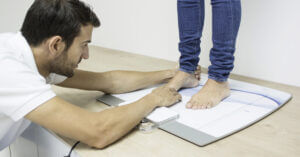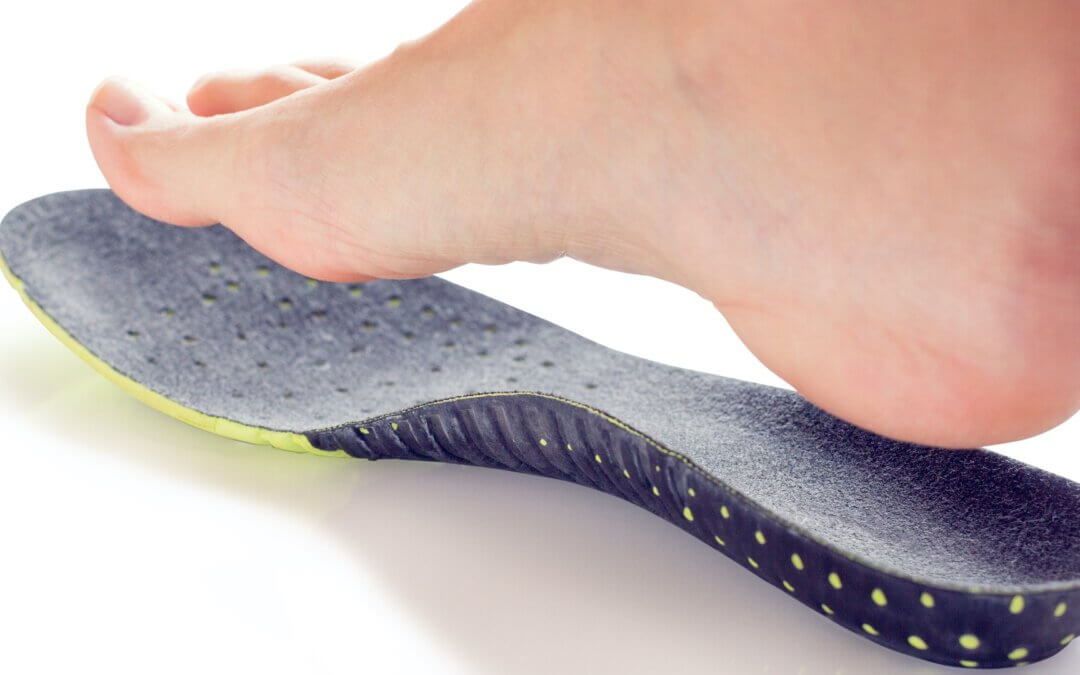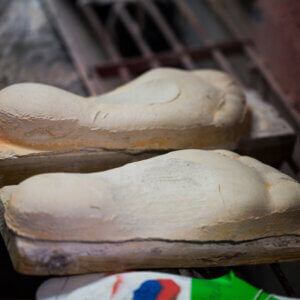Two categories of foot orthosis
A foot orthosis varies from an insole in modern terminology as it is shaped while the insole is flat. There are two distinct orthotic types on the market —those available from internet sources and chemists and those prescribed by professionals. Podiatrists have to understand the difference between commercial orthoses and learn about prescription orthoses – made to measure for each foot. To broaden the definition of Orthosis (noun) and orthotic (adjective), these devices do not apply to the feet alone and may involve knee braces and even toe splints. They are different to prostheses which are used to make up the loss and function of a part or whole limb.

an orthosis being made to specific prescription
An orthosis is a facility to help improve foot function by alleviating pain and poor tendon and muscle function. For example, forefoot pain, often loosely called metatarsalgia, will improve because the orthosis can alter the pressure distribution. Additions to orthoses can be added but preferably with professional guidance. Most people will have come across the older steel arch plates with their rivets, promoted by Scholl’s, an international commercial firm selling over the counter foot health products. The thin metal was bent to shape for minor adjustments but mass-produced and different to modern designs. Newer designs control the foot through controlling excessive movement through the complex midfoot and hindfoot joints of the foot.
An orthosis can assist in correcting abnormal foot function. The device must be constructed to have an accurate contour using casts or computerised impressions of the intimate structure of the foot. Once corrected, the orthosis can influence muscle balance just as the prescription lens would alter the optical muscles to improve sight – vision is now equated to locomotion (human movement). The foot and leg are intimately linked through the ankle bone (talus). Therefore, a foot orthosis could influence leg rotation and aid knee pain and hip pain associated with too much movement. Some patients have found back pain improved as the as the rotation in the leg connects to the hip and has an intimated relationship through the hip joint and pelvis. As we walk the pelvis moves forwards and backward and well as tilts laterally.
A positive mold of feet bears similarity to dental impressions for accurate replication of foot contours
Mass produced products
The old Scholl orthosis worked on ‘jacking’ up the arch until the client could no longer tolerate the discomfort. The patient must guard against this method otherwise the orthosis will languish in a drawer. An over-the-counter orthosis will not harm most people. The soft material, if helpful is fine, but offers less foot control. The stiffer and less flexible materials can cause fit and comfort problems depending on the foot type. Prescription orthoses are not required for most people and lower-cost alternatives can work adequate, but not for everyone.
 A podiatric consultation is wise for medical foot problems (diabetes, rheumatoid, psoriatic arthritis, compound arch pain, or deformity). Skin problems including congenital blistering should be assessed to avoid damage from an orthosis. High-performance athletes are best consulting a podiatrist with a sports interest as the market is broad and confusing for laypeople. Existing knee and hip problems should be assessed by a professional before considering an orthosis. For the average person with a normal functioning nerve and muscle system, with normal bone and joint development, expensive, highly technical gait assessment laboratory work is not required. However, visually recorded gait patterns are often invaluable for charting progress and improved muscle work. Commercial pressure platforms can identify abnormal pressures and guide altered posture but should be used by trained professionals with appropriate qualifications.
A podiatric consultation is wise for medical foot problems (diabetes, rheumatoid, psoriatic arthritis, compound arch pain, or deformity). Skin problems including congenital blistering should be assessed to avoid damage from an orthosis. High-performance athletes are best consulting a podiatrist with a sports interest as the market is broad and confusing for laypeople. Existing knee and hip problems should be assessed by a professional before considering an orthosis. For the average person with a normal functioning nerve and muscle system, with normal bone and joint development, expensive, highly technical gait assessment laboratory work is not required. However, visually recorded gait patterns are often invaluable for charting progress and improved muscle work. Commercial pressure platforms can identify abnormal pressures and guide altered posture but should be used by trained professionals with appropriate qualifications.
Read more about orthoses and don’t get ripped off! Biomechanics and the foot orthosis
David Tollafield is a registered podiatrist and qualified from University College Hospital (London Foot Hospital) in 1978. In 1981 he travelled to the USA to study podiatric biomechanics sponsored by the Silver Jubilee and Churchill Fellowship Foundation. His first degree was in transducer studies in the foot and human locomotion study at Coventry University (1990). He was awarded his Fellowship of the Royal College of Podiatry in Podiatric Medicine FRCPodM and his surgical fellowship FRCPodS. He was Director of Curtis Orthotic Laboratory (1981-85) and senior lecturer in Podiatric Orthopaedics at the University of Northampton (1985-1994). His autobiography – “Podiatrist on a Mission”, is available from Amazon, published by Busypencilcase Communications 2021.

Sign-up for here my regular FREE newsfeed
‘What is an orthosis?’ by David R Tollafield
Published 17 January 2022

Busypencilcase Communications Est. 2015


Trackbacks/Pingbacks